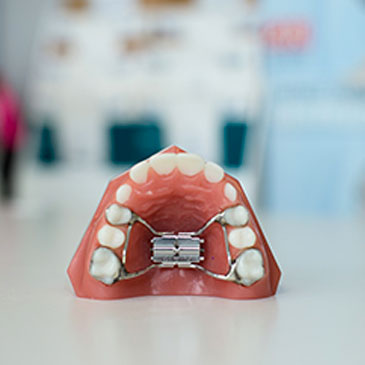- Anchorage:
- (907) 272-3200
- Wasilla:
- (907) 376-0815
Other Treatments
Strategies for better alignment and a proper bite

Habit Appliance
A habit appliance helps stop certain repeated body motions (habits). Some correctors help stop tongue thrusting (pressing the tongue against the front teeth) while others correct finger and thumb sucking. These habits can adversely affect the bite and change the position of your teeth and growing jaws.

Herbst Appliance
The Herbst appliance reduces overbite by encouraging the lower jaw forward and the upper molars backward. This fixed appliance is used mostly for younger, growing children and is worn for about 12-15 months.

Palatal Expander
The palatal expander “expands” (or widens) your upper jaw by putting gentle pressure on your upper molars each time an adjustment is made. Dr. Duclos will instruct you about when and how to adjust your expander. When you achieve the desired expansion, you will wear the appliance for several months to solidify the expansion and to prevent regression.

Retainers
Retainers may be removable or fixed. They hold your teeth in their new, correct positions after your teeth have been straightened. Dr. DuClos will instruct you on how to care for your retainer and about the duration of the wear. Wearing your retainer as directed is crucial to prevent regression of your treatment.

Space Maintainers – Nance Appliance
A Space maintainer is recommended for children who have lost their primary (baby) teeth too soon. Primary teeth are considered Mother Nature’s way of space maintenance. In the instance that a baby tooth is extracted, damaged or falls out too soon, a space maintainer is recommended.
Nance appliance – indicated for loss of multiple primary teeth of the upper arch. An acrylic button provides increased stability. Appliance prevents tipping and any rotation or movement of molars.

Space Maintainers – Lower Lingual Holding Arch
Lower lingual holding arch – indicated for loss of primary teeth of the lower arch. A wire adapted to the lingual side of the teeth connected by two molar bands. Appliance stabilizes molar position and to maintain the needed space for erupting permanent teeth.
Orthognathic Surgery
What Is It?
Corrective jaw surgery (orthognathic surgery) treats and corrects abnormalities of the facial bones, specifically the jaws and the teeth. Often, these abnormalities cause difficulty associated with chewing, talking, sleeping and other routine activities. Orthognathic surgery corrects these problems and, in conjunction with orthodontic treatment, will improve the overall appearance of the facial profile.
What it Entails
Using the latest in digital imaging technology, we will demonstrate the overall functional and aesthetic benefits of orthognathic surgery. Computerized treatment planning minimizes treatment times, recovery periods and the overall efficacy of your surgery. State-of-the-art materials such as titanium plates and miniature screws provide stability, strength and predictability to your treatment. These advances in technology, procedures and equipment reduce post-surgical recovery time, thus allowing patients to return to their normal routines soon after the surgery.
Orthognathic surgery may be unnecessary if orthodontic treatment can correct the problem. With the latest advances in orthodontics, this is sometimes the case. We will determine if orthognathic surgery is the correct treatment option for you.

